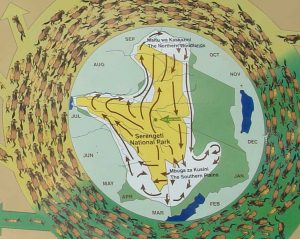Safari Great Migration
The migration in East Africa is world-renowned. 1.5-2 million wildebeests (white-bearded gnu) participate in the migration through Tanzania and Kenya. Up to 500,000 of zebra and gazelles join them on the journey. It is the largest movement of animals in the world.
Highlights include:
- River Crossings
- Calving
- Predators
Although lions and other carnivores do not migrate with the grazing animals, they feast on them when their paths cross.
The best time to see the migration in Tanzania is often January-March and June-August. In the Kenya, it is often best September-October. The migration timing depends on the water resources, and the animals move daily. Therefore, it is impossible to predict exactly, but your safari guide will know where the animals are. You will will have the opportunity to see incredible wildlife at any time of year!
| JANUARY: | Southern Serengeti and Northern Ngorongoro Conservation Area (Ndutu) |
| FEBRUARY: | Southern Serengeti and Northern Ngorongoro Conservation Area (Ndutu) (calving season) |
| MARCH: | Southern Serengeti and Northern Ngorongoro Conservation Area (Ndutu) |
| APRIL: | Southern Serengeti and Northern Ngorongoro Conservation Area (Ndutu) |
| MAY: | Southern Serengeti |
| JUNE: | Central and Western Corridor of Serengeti |
| JULY: | Central and Western Corridor of Serengeti |
| AUGUST: | Northwestern Serengeti, Masai Mara |
| SEPTEMBER: | Masai Mara |
| OCTOBER: | Masai Mara, Northeastern Serengeti |
| NOVEMBER: | Masai Mara, Northeastern Serengeti |
| DECEMBER: | Eastern and central Serengeti |
To maximize the experience:
- Add extra days to your safari to follow the migration.
- Stay at a tented camp for true “bush” experience.
- Start your game drive early in the morning.
- Add a hot air balloon safari.
- Stay at a conservation area in Kenya that allows walking safaris and night game drives.
Contact Us for the best migration safari option for you!
